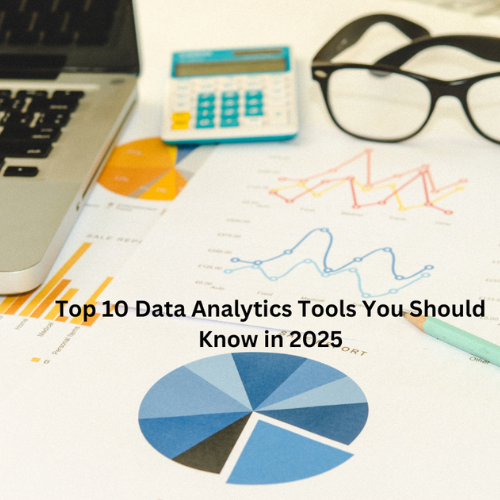Data analytics has become a core part of business intelligence, helping organizations make data-driven decisions, improve operational efficiency, and gain a competitive edge. With advancements in technology, the data analytics landscape in 2025 is filled with innovative tools that cater to various needs, from big data processing to real-time analysis and machine learning. Here are the top 10 data analytics tools that you should know in 2025.
1. Microsoft Power BI
Overview
Microsoft Power BI continues to be a popular tool for data visualization and business analytics in 2025. It enables users to create interactive reports and dashboards that offer real-time insights.
Key Features
- User-Friendly Interface: Designed with drag-and-drop functionalities for easy report creation.
- Data Connectivity: Supports a variety of data sources, including Excel, SQL databases, cloud services, and more.
- Artificial Intelligence (AI) Integration: Offers built-in AI features for predictive analytics and automation.
- Mobile Access: View dashboards and reports on mobile devices for on-the-go insights.
Best For
Businesses of all sizes looking for a powerful yet user-friendly data visualization tool.
2. Tableau
Overview
Tableau remains one of the most popular data analytics tools due to its advanced data visualization capabilities. Known for its ability to handle large datasets, Tableau makes it easy to convert raw data into interactive, visual reports.
Key Features
- Extensive Visualization Options: Offers various chart types, maps, and graphs to present data creatively.
- High Performance: Capable of processing large amounts of data with minimal latency.
- Tableau Prep: Streamlines data cleaning and preparation for faster analysis.
- Collaboration: Enables teams to share dashboards and work together seamlessly.
Best For
Analysts and data scientists who need advanced visualization options and efficient data handling.
3. Apache Spark
Overview
Apache Spark is an open-source analytics engine known for its speed and ease of use. Built for big data processing, Spark is highly suitable for complex analytics tasks, such as machine learning and real-time data streaming.
Key Features
- In-Memory Processing: Provides faster data processing than traditional disk-based systems.
- Scalability: Supports large-scale analytics and machine learning applications.
- Multi-Language Support: Compatible with Python, Java, R, and Scala.
Best For
Organizations dealing with massive datasets and requiring fast, scalable data processing.
4. Google Data Studio
Overview
Google Data Studio is a free data visualization tool that integrates well with other Google products like Google Analytics, Google Ads, and BigQuery. It’s ideal for creating shareable, interactive dashboards.
Key Features
- Data Source Integration: Connects easily with Google’s suite of tools as well as external data sources.
- Customizable Dashboards: Allows users to build customized reports with drag-and-drop options.
- Collaboration: Share and edit reports in real time with team members.
- Free to Use: Provides robust data visualization capabilities at no cost.
Best For
Small to medium-sized businesses and teams already using Google products for their analytics needs.
5. R Programming
Overview
R is a statistical programming language and software environment used for data analytics, especially popular among data scientists. Its comprehensive statistical capabilities make it ideal for advanced analytics.
Key Features
- Extensive Statistical Libraries: Offers numerous libraries for data manipulation, analysis, and visualization.
- Data Visualization: Known for its excellent graphing capabilities with packages like ggplot2.
- Open Source: Free to use and has a large, supportive community.
- Machine Learning Support: Offers packages for machine learning and statistical modeling.
Best For
Data scientists and statisticians who need powerful statistical tools and open-source flexibility.
6. Python
Overview
Python remains a top choice for data analytics in 2025 due to its versatility and ease of use. Python’s libraries like Pandas, NumPy, and Matplotlib make it a complete toolkit for data manipulation, analysis, and visualization.
Key Features
- Comprehensive Libraries: Offers libraries for every step of the analytics process, including machine learning with Scikit-Learn and deep learning with TensorFlow.
- Cross-Platform Compatibility: Works on various operating systems and is widely supported.
- Easy to Learn: Features an intuitive syntax, making it easy for beginners to learn.
- Integration: Integrates with big data tools like Hadoop and Spark.
Best For
Data analysts and data scientists who need a versatile, all-purpose language for analytics, machine learning, and automation.
7. Alteryx
Overview
Alteryx is an easy-to-use platform designed to streamline data preparation, blending, and analytics.With Alteryx, users can automate repetitive data tasks and perform advanced analytics without extensive coding.
Key Features
- Data Preparation: The drag-and-drop interface simplifies data cleaning and blending.
- Automated Workflows: Automates repetitive tasks and integrates seamlessly with other analytics tools.
- Predictive Analytics: Provides built-in tools for predictive analytics and machine learning.
- Integration: Connects with data sources like databases, APIs, and cloud storage.
Best For
Data analysts and business users looking for a code-free solution for data preparation and automation.
8. SAS
Overview
SAS (Statistical Analysis System) is a trusted tool for advanced analytics, business intelligence, and data management. SAS has been a leader in analytics for decades, providing comprehensive solutions for data scientists.
Key Features
- Advanced Analytics: Offers a range of tools for statistical analysis and machine learning.
- Data Security: Known for high standards of data governance and security.
- Scalability: Suitable for large enterprises that need a robust, secure analytics platform.
- Data Management: Includes capabilities for data cleaning, preparation, and warehousing.
Best For
Large enterprises that need a highly secure and scalable data analytics solution.
9. Qlik Sense
Overview
Qlik Sense is a data analytics tool known for its unique associative engine, which allows users to explore data without being limited to linear queries. This facilitates intuitive and insightful data exploration.
Key Features
- Associative Data Engine: Enables users to explore data freely and discover hidden relationships.
- Self-Service Analytics: Designed for both technical and non-technical users to build their own dashboards.
- AI-Powered Insights: Provides AI-driven insights and suggestions for data relationships.
- Multi-Cloud Support: Offers flexible deployment options across cloud platforms.
Best For
Organizations looking for an intuitive tool that encourages data exploration and discovery.
10. Databricks
Overview
Databricks is a unified data analytics platform optimized for big data and machine learning. Built on Apache Spark, Databricks offers a collaborative platform for data engineers, data scientists, and business analysts.
Key Features
- Optimized for Apache Spark: Runs on a highly optimized version of Apache Spark for faster performance.
- Machine Learning: Includes MLflow for machine learning lifecycle management.
- Collaboration: Provides a shared workspace for teams to work together on projects.
- Cloud-Based: Available on major cloud platforms, including AWS, Azure, and Google Cloud.
Best For
Organizations with advanced big data and machine learning requirements, needing a collaborative and scalable platform.
Choosing the Right Data Analytics Tool
Selecting the best tool for your needs in 2025 depends on several factors, including:
- Data Volume: Consider big data tools like Apache Spark and Databricks if you’re working with large datasets.
- Budget: Free tools like Google Data Studio and R may be suitable if cost is a constraint.
- Technical Skill Level: Tools like Alteryx and Qlik Sense are designed for users with little to no coding experience.
- Specific Requirements: For statistical analysis, tools like R and SAS excel, while Power BI and Tableau are top choices for visualization.
Conclusion
Data analytics tools continue to evolve, providing new ways to analyze and interpret data. The tools listed above represent the best of what’s available in 2025, each with unique strengths to meet various analytics needs. Whether you’re a business user, data scientist, or IT professional, choosing the right tool can significantly impact your ability to derive actionable insights and drive growth. If you’re aiming to deepen your expertise and maximize these tools, consider enrolling in the Best Data Analytics Training Course in Noida, Delhi, Mumbai, Indore, and other parts of India to build a solid foundation and stay ahead in the competitive analytics field.




